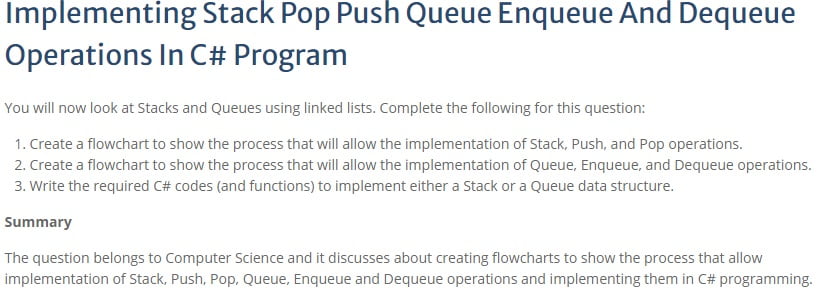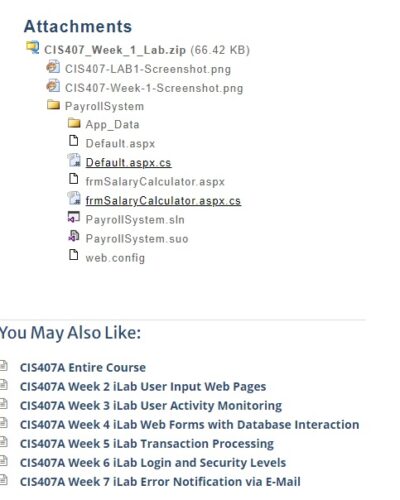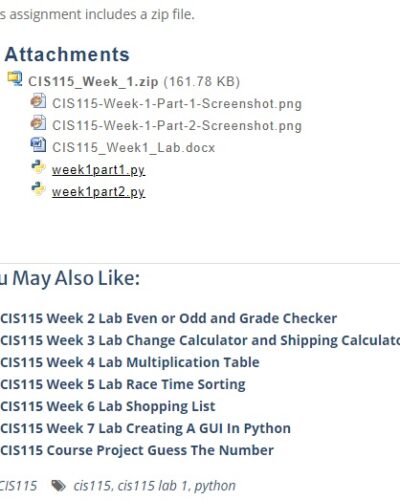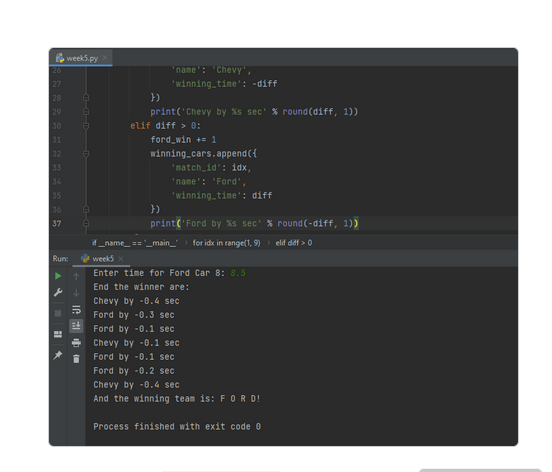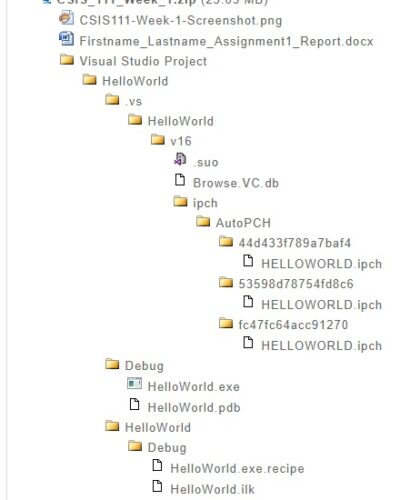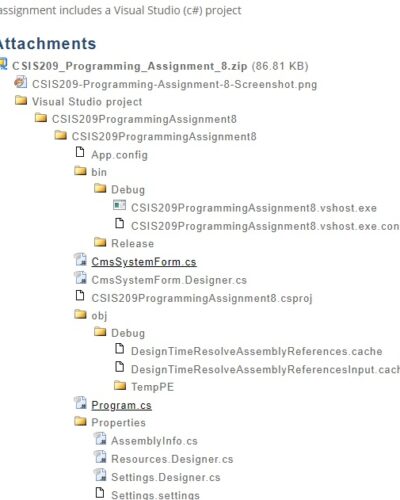VB/C# ENTIRE COURSE HELP
$149.99$275.00
VB/C# ENTIRE COURSE HELP
Visual Basic 2010 How to Program Deitel Exercise 5.5 Retail Sales Calculator Application
(Retail Sales Calculator Application) An online retailer sells five products whose retail prices are as follows: Product 1, $2.98; product 2, $4.50; product 3, $9.98; product 4, $4.49 and product 5, $6.87. Write an application that reads a series of pairs of numbers as follows:
product number; quantity sold.
Description
VB/C# ENTIRE COURSE HELP
Visual Basic 2010 How to Program Deitel Exercise 5.5 Retail Sales Calculator Application
(Retail Sales Calculator Application) An online retailer sells five products whose retail prices are as follows: Product 1, $2.98; product 2, $4.50; product 3, $9.98; product 4, $4.49 and product 5, $6.87. Write an application that reads a series of pairs of numbers as follows:
product number; quantity sold.
Your program should use a Select…Case statement to determine the retail price for each product. It should calculate and display the total retail value of all products sold in an output Label as shown in Fig. 5.21. Keep the total retail value up to date as the user enters values.
Hint: Create instance variables to store the quantity sold of each product so the values are maintained between calls to the event handler.
VB/C# ENTIRE COURSE HELP
Visual Basic 2010 Shelly Cashman Series Chapter 8 Case Problem 5 MISTY RIVER CAMPGROUND RATES
MISTY RIVER CAMPGROUND RATES
Design a Windows application and write the code that will execute according to the program requirements in Figure 8-82. Before designing the user interface, create a Use Case definition. Before writing the code, create an event planning document for each event in the program.
REQUIREMENTS DOCUMENT
Date submitted: March 17, 2014
Application title: Misty River Campground Rates
Purpose: This application assists the campground manager to compute the total bill for a camping stay at a campground.The application will calculate the total cost including 7.5% state tourist tax.
Program Procedures: The user can select the type of campground site, number of days, and type of discount program.
Algorithms, Processing, Conditions:
- The user first views a Windows form that displays the campground name, a picture of and the campground, a ComboBox object requesting the type of site: tent site $20 a night, RV site $35 a night, or cabin rental $55 a night, the number of nights (TextBox object), and if they have one of the following discounts: AAA (10%) or Military (12%).
- After the information has been entered, a Sub procedure displays the labels: Subtotal Billing Amount for Your Stay,Taxes for Your Stay, and Final Total.
- Pass the cost of the type of camping site and the number of nights to a Sub procedure to calculate the subtotal of the camp site.Do not display the amount in this procedure.
- Pass the subtotal and the discount amount to a Function procedure.Determine the subtotal based on the type of discount. Pass the amount back to the calling method.
- Another Function procedure should compute the 7.5% tax. Pass that value back to the calling method.
- Pass the subtotal, tax, and final cost to a Sub procedure to display the results.
Notes and Restrictions: The input values should be validated in a separate procedure by a Try-Catch block.
Comments: The picture should be selected from pictures available on the Web.
VB/C# ENTIRE COURSE HELP
Microsoft Visual Basic 2010 Shelly Cashman Series Chapter 6 Case Problem 7 Factorial Math
Create a requirements document and a Use Case Definition document, and design a Windows application based on the case project shown in Figure 6-134:
Most calculators have an operation called a “factorial” which is shown on a calculator key as an exclamation point. For example 5! (5 factorial) multiplies 5 * 4 * 3 * 2 * 1 to calculate the result of 120. Using loops to compute the factorial, display the following factorials in a Listbox object:
1! 1
2! 2
3! 6
4! 24
5! 120
6! 720
7! 5040
8! 40320
VB/C# ENTIRE COURSE HELP
Microsoft Visual Basic 2010 Shelly Cashman Series Chapter 4 Case Problem 6 Convert Currency
Convert Currency
Design a Windows application and write the code that will execute according to the program requirements in Figure 4-109. Before designing the user interface, create a Use Case definition. Before writing the code,create an event planning document for each event in the program.
REQUIREMENTS DOCUMENT
Date submitted: November 4, 2014
Application title: Convert Currency
Purpose: The Convert Currency Windows application will display the value of U.S. dollars in euros, English pounds, and Mexican pesos.
Program Procedures: From a window on the screen, the user should enter the number of U.S. dollars to be converted. The program will display the equivalent value in euros, British pounds, and Mexican pesos.
Algorithms, Processing, and Conditions:
- The user must be able to enter the number of U.S. dollars to be converted.
- After entering the number of U.S. dollars to be converted, the user clicks the Convert Currency button.
- The program converts the number of U.S. dollars entered into the equivalent number of euros, English pounds, and Mexican pesos. The program displays all three currencies together with the U.S. dollars.
- To find the conversion rates, the developer must consult the appropriate Web sites.A possible site is www.xe.com.
- Because the currency rates change dynamically, the user should enter both the date and the time that the conversion rates were applied. The date and time should be displayed in U.S. format.
- The user should be able to clear the date and time, the number of U.S. dollars entered, and the results of the calculations, and then enter new values.
Notes and Restrictions: The user should be able to click an exit button to close the application.
Comments: The designer must determine the design of the user interface, and the words and graphics used in the user interface.
VB/C# ENTIRE COURSE HELP
Microsoft Visual Basic 2010 Shelly Cashman Series Chapter 5 Case Problem 7 Technology Conference Registration
Technology Conference Registration
Based on the case project shown in Figure 5-111, create a requirements document and a UseCase Definition document, and then design a Windows application. Before writing the code, create an event planning document for each event in the program.
It is important that developers update their skills by attending developers conferences. The Dynamic International Management Consorttium (DIMC) runs and manages the ADSE (Active Developers Skill Enhancement) Conference two times per year. To encourage companies to send multiple employees to the conference, the cost per attendee is determined based on the number of attending developers from a given company. The table below specifies cost per attendee.
[table]
Number of Conference~~Registration per~~Company,Cost per Attendee
1, $695
2-4, $545
5-8, $480
8 or more, $395
[/table]
DIMS has requested that you develop a Windows application that can determine and display the total cost per company for developers attending the conference. DIMC has a conference policy that states if any member of a company has attended a previous DIMC conference, the company receives a 15% discount from the total cost of its employees who attend. The policy also states that no more than 16 people from a single company can attend the conference. DIMC has asked that you design the program so that the user must enter valid data.
VB/C# ENTIRE COURSE HELP
Visual Basic Program Car Shoppers Inc
In an effort to boost sales, Car Shoppers Inc. is offering buyers a choice of either a large cash rebate or an extremely low financing rate, much lower than the rate most buyers would pay by financing the car through their local bank. Jake Miller, the manager of Car Shoppers Inc., wants you to create an application that helps buyers decide whether to take the lower financing rate from his dealership, or take the rebate and then finance the car through their local bank. Be sure to use one or more independent Sub procedure in the application, as this will be an important element in grading this Lab.
Consider using the handy Financial.Pmt() method to calculate the payments. A design suggestion for the form is shown below:
VB/C# ENTIRE COURSE HELP
Visual Basic 2010 How to Program Deitel Chapter 7 Salary Survey Application
Use a one-dimensional array to solve the following problem:
A company pays its salespeople on a commission basis. The salespeople receive $200 per week, plus 9% of their gross sales for that week. For example, a salesperson who grosses %5,000 in sales in a week receives $200 plus 9% of $5,000, a total of $650.
Write an application (using an array of counters) that determines how many of the salespeople earned salaries in each of the following ranges (assuming that each salesperson’s salary is truncated to an integer amount): $200-299, $300-399, $400-499, $500-599, $600-699, $700-799, $800-899, $900-999, and over 999.
Allow the user to enter the sales for each employee in a TextBox.
The user clicks the calculate Button to calculate the salesperson’s salary.
When the user is done entering this information, clicking the Show Totals Button displays how many of the salespeople earned salaries in each of the above ranges.
VB/C# ENTIRE COURSE HELP
Advanced Visual Basic 2010 Chapter 3 Programming Challenge 6 FirstPlay Sports Rental
Create an application named FirstPlay Sports Rental that keeps track of the inventory for a sports rental store.
Requirements Specification
- The user can input a new rental item and add it to the store inventory.
- The user can select an item’s ID Number from a list and remove the item from the inventory.
- The user can select an item’s ID Number from a list and display the item’s properties.
- When the application starts, it reads an inventory list from a file (text format).
- When the application ends, it writes the inventory list back to the same file.
User Interface Details
Display a single sports rental item in a window, as shown in Figure 3-23. Each item has an ID number; a description; daily, weekly, and monthly rental rates; and the quantity on hand. When the application starts, it reads all item information from a file into a collection (implemented as a Dictionary) and copies the item ID numbers into a combo box on the form. The user can select an ID number from the combo box, and display or remove existing items. The user can also add new items to the collection. When the program ends, it writes the collection to the same file.
Startup Form
The application’s startup form displays inventory items and lets users carry out each of the following actions:
- Input fields for a new rental item, and add that item to the inventory.
- Select an item’s ID Number and remove the item from the inventory.
- Select an item’s ID Number and display the item’s properties.
When the form loads, the combo box should contain a list of all inventory ID Numbers.
Returning to Figure 3-23 for a moment, we see that it shows a new item about to be added to the store inventory. When the Add Current Item button is clicked, the button’s handler creates a new Item object and passes it to the class that handles the store inventory. Figure 3-24 shows an example of searching for an item by ID Number. When the user clicks the Display Item button, the remaining item fields are filled in. When the user clicks the Remove Current Item button, the program confirms the operation with the user, as shown in Figure 3-25. If the answer is yes, the program removes the item identified by the ID Number.
Classes
We suggest that the application define three classes: Item, Inventory, and InventoryFile.
- The Item class encapsulates a single inventory item.
- The Inventory class represents a collection that contains all items and provides methods for adding, finding, and removing items. Internally, it should hold the items in a Dictionary object.
- The InventoryFile class is responsible for reading the inventory data from a text file, and writing all Inventory data back to the file.
VB/C# ENTIRE COURSE HELP
Programming in VB 2010 Chapter 11 Case Study Video Bonanza
Modify your project from Chapter7 to save the changes to the movie combo box from one run to the next. When the program begins, load the list from the data file. If the file does not exist, display a message asking if the user wants to create it.Allow the user to save changes from a Savemenu item. When the program terminates, check to see if there are any unsaved changes. If so, prompt the user to save the changes.
Optional extra: Allow the user to select the file to open using the Open Filedialog box.
In addition, when the program starts use an OpenFileDialog to prompt the user for the file to open.
When the form closes, use SaveFileDialog to prompt the user for the file when saving.
VB/C# ENTIRE COURSE HELP
Programming in VB 2010 Video Bonanza Chapter 10 Case Study
Create a Windows application to display the information from the Studio table in the VBVideo.mdf database file from the StudentData folder on the text Web site. Allow the user to select the studio name from a sorted drop-down list and display the rest of the fields in labels.
Create a Windows or Web application to display the Studio table in a grid. Hint: For a Web application, use a DataList control for the grid.
The Studio table contains these fields:
StudioID
StudioName
ContactPerson
Phone
VB/C# ENTIRE COURSE HELP
Programming in VB 2010 Video Bonanza Chapter 8 Case Study
Create a project that displays the aisle number of a movie category in a label. The movie categories will be in a list box. Store the aisle numbers and categories in an array.
A Search button should locate the correct location from the array and display it in a label. Make sure that the user has selected a category from the list and use the list box SelectedIndex property to find the appropriate aisle number.
Table Data:
Aisle 1 Comedy
Aisle 2 Drama
Aisle 3 Action
Aisle 4 Sci-Fi
Aisle 5 Horror
Back Wall New Releases
VB/C# ENTIRE COURSE HELP
Advanced Visual Basic 2010 Chapter 9 Programming Challenge 5 Vacation Rentals with Validation
Use the Vacation Rentals application presented in Section 9.7 as a starting point for this programming challenge. Add the following validation rules to the Rental Request page, using the ASP.NET validation controls:
- All inputs are required.
- The number of people must be between one and eight.
- The number of weeks must be between one and twelve.
- The starting date must be at least three days from today but not greater than 120 days from today.
The default first item in the Location DropDownList should be (select). Add an email input field to the Vacation Rental Request Web page. Use RequiredFieldValidator and RegularExpressionValidator controls to make sure the email is not blank and that it is a valid email address. Add a ValidationSummary control to the page. Use Figure 9-52 as a sample of the user interface, shown after the user has entered all inputs.
You will need to add an email field to the RentalInfo class so the user’s email can be preserved in Session state when returning from the Confirmation form to the Rental Request page.
VB/C# ENTIRE COURSE HELP
Visual Basic Application JM Sales
JM Sales employs five salespeople. The sales manager wants an application that allows him to enter any number of sales amounts for each of the five salespeople.
The application should accumulate the sales amounts in a one-dimensional array. The application also should display an on-form “report” with the resulting data as indicated in the sample form below. That display should contain each salesperson’s ID and total sales. It also should display the total company sales.
We suggest that the textbox that displays the resulting data has its BorderStyle property set to Fixed3D, its Font property set to Courier New 10 point, its MultiLine and ReadOnly properties set to True, and its ScrollBars property set to Vertical.
Test it thoroughly with many possible additional combinations of data.
VB/C# ENTIRE COURSE HELP
Penn Foster Graded Project 03784300 Windows Forms and Applications
OVERVIEW
This project will assess your understanding of accessing files, using data-bound controls, and deploying your application.
Make sure that you follow all directions completely and verify your results before submitting the project. Remember to include all required components in your solution.
YOUR PROJECT
In the graded project for Lesson 4, you added the GroceryItemForm to the GroceryApp project. In this project, you’ll
- Add functionality to save and load saved grocery basket files
- Display the contents of the basket using the data-bound control DataGridView
- Add a form to the project to display grocery items in the basket
- Locate and share your application assembly with your instructor
Note: This project is the last graded project based on this scenario. You’ll be graded on the end-user functionality, so variable names and other code conventions are your choice, but the application must behave as expected.
INSTRUCTIONS
- In Visual Studio, load the GroceryApp project that you completed in Lesson 4.
- Open the GroceryItemForm.vb file.
- Add the options &Save and &L oad to the Application menu above the Exit option. You can add the Save and Exit options to the Application menu underneath Exit and then click and drag them above it.
- Add the OpenFileDialog and SaveFileDialog components to the Windows form.
- In the Click event for the Save option, prompt the user for a file location and store the basket as a text file. Recall that grocery items are stored in the basket variable.
Hint: You could use a CSV file similar to a flat-file database, like the example in Section 2 of Lesson - In the Click event for the Load option, prompt the user for a file location and load the contents of the text file into the basket. Make sure you empty the basket first.
Hint: You could use the Split method in the String class to break each line into individual array items. See the MSDN Library at http://tinyurl.com/3odx56 for more details. - Save your work and test the application.
- Add some items to the basket and save them.
- Then attempt to load them again.
- Click on the View option in the Basket menu to see the basket contents. You will modify how this menu option works in the concluding steps.
- Add a new form to the project named BasketDisplayForm.
- Set the Text property to Basket Contents.
- Set the Size property to 600, 300.
- Add a DataGridView control named viewBasket.
- Set the Dock property of the DataGridView control to Fill.
- In the Load event of the BasketDisplayForm, add the following code to display the basket contents in the DataGridView control:
- viewBasket.DataSource = basket
- Notice how simple it is to perform data-binding with collections.
- Go back to the code view of GroceryItemForm.
- Replace the content of the ViewToolStripMenuItem_Click event handler, so that it loads and displays the BasketDisplayForm modally.
Hint: You don’t have to worry about the basket variable, because the BasketDisplayForm handles data-binding in its Load event.
- Save and run the application. Verify that all controls and menus work correctly. You’ll submit the compiled application for this project.
SUBMISSION GUIDELINES
You’ll submit the GroceryApp.exe file for your project. To find this file, you should go to directory where you saved the GroceryApp project. To open the project directory, right-click on GroceryApp in the Solution Explorer panel and choose the Open Folder in File Explorer option in the context menu.
Go to the bin\Debug folder and copy the GroceryApp.exe file to your desktop or any other temporary location. You should make sure the GroceryApp.exe file executes before submission. You can double-click on it without using Visual Studio for testing.
GRADING CRITERIA
Your project will be graded using the following rubric:
[table]
TOTAL, 100 points
The Save menu option performs the correct behavior, 30 points
The Load menu option performs the correct behavior, 30 points
The View menu option performs the correct behavior, 15 points
The BasketDisplayForm is laid out correctly 15, points
The compiled application is included and runs, 10 points
[/table]
VB/C# ENTIRE COURSE HELP
Implement a Hash Algorithm in C#
Students will create code to implement a hash algorithm and solution by addressing the following:
- Create a flowchart to show the processing that will take place for the implementation of a hash structure.
- Present the flowchart for the hash function operation separately.
- Write the necessary C# code that will create and use a hash algorithm to store data in a structure. Use a linked List to resolve potential collisions.
VB/C# ENTIRE COURSE HELP
Implementing Stack Pop Push Queue Enqueue And Dequeue Operations In C# Program
You will now look at Stacks and Queues using linked lists. Complete the following for this question:
- Create a flowchart to show the process that will allow the implementation of Stack, Push, and Pop operations.
- Create a flowchart to show the process that will allow the implementation of Queue, Enqueue, and Dequeue operations.
- Write the required C# codes (and functions) to implement either a Stack or a Queue data structure.
Summary
The question belongs to Computer Science and it discusses about creating flowcharts to show the process that allow implementation of Stack, Push, Pop, Queue, Enqueue and Dequeue operations and implementing them in C# programming.

